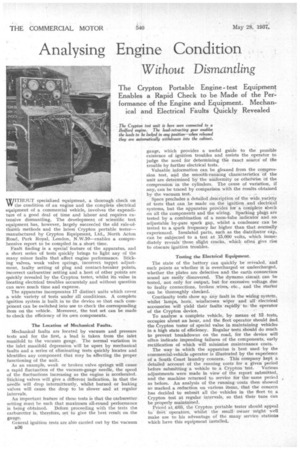Analysing Engine Condition
Page 50

If you've noticed an error in this article please click here to report it so we can fix it.
Without Dismantling
The Crypton Portable Engine test Equipment Enables a Rapid Check to be Made of the Performance of the Engine and Equipment. Mechanical and Electrical Faults Quickly Revealed
%WITHOUT specialized equipment, a thorough check on VV the condition of an engine and the complete electrical equipment of a commercial vehicle, involves the expenditure of a good deal of time and labour and requires extensive dismantling. The development of scientific test equipment has, however, largely succeeded the old rule-ofthumb methods and the latest Crypton portable tester-manufactured by Crypton Equipment, Ltd., North Acton Road, Park Royal, London, N.W.10—enables a comprehensive report to be compiled in a short time.
Fault finding is a special feature of the apparatus, and a short series of tests quickly brings to light any of the many minor faults that affect engine performance. 'Sticking valves, weak valve springs, incorrect tappet adjustment, faulty setting of plug and contact-breaker points, incorrect carburetter setting and a host of other points are quickly revealed by the Crypton tester, whilst its value in locating electrical troubles accurately and without question can save much time and expense.
The apparatus incorporates 17 distinct units which cover a wide variety of tests under all conditions. A complete ignition system is built in to the device so that each component can be switched into use to check the corresponding item on the vehicle. Moreover, the test set can be made to check the efficiency of its own components.
The Location of Mechanical Faults.
Mechanical faults are located by vacuum and pressure tests and for the first, a lead is taken from the inlet manifold to the vacuum gauge. The normal variation in the inlet manifold depression will be upset by mechanical faults and a series of eliminating tests quickly locates and identifies any component that may be affecting the proper functioning of the unit.
As an example, weak or broken valve springs will cause a rapid fluctuation of the vacuum-gauge needle, the speed of the fluctuations increasing as the engine is accelerated. Sticking valves will give a different indication, in that the needle will drop intermittently, whilst burned or leaking valves will cause the drop to be slower and at regular intervals.
An important feature of these tests is that the carburetter setting must be such that maximum all-round performance is being obtained. Before proceeding with the tests the carburetter is, therefore, set to give the best result on the gauge.
General ignition tests are also carried out by the vacuum n36
gauge, which provides a useful guide to the possible existence of ignition troubles and assists the operator to judge the need for determining the exact source' of the
trouble by further electrical tests. •
Valuable information can be gleaned from the compression test, and the smooth-running 'characteristics of the unit are determined by the uniformity or otherwise of the compression in the cylinders. The cause of variation, if any, can be traced by comparison with the results obtained by the vacuum test.
Space precludes a detailed description of the wide. variety of tests that can be made on the ignition and electrical systems, but the apparatus provides for a complete :heck on all the components and the wiring. Sparking plugs are tested by a combination of a neon-tube indicator and an adjustable by-pass spark gap, whilst a condenser can be tested to a spark frequency far higher than that normally experienced. Insulated parts, such as the distributor cap, can be subjected to a test at 15,000 volts, which immediately reveals those slight cracks, which often give rise to obscure ignition troubles.
Testing the Electrical Equipment.
The state of the battery can quickly be revealed, and such points as whether it is overcharged or undercharged, whether the plates are defective and the earth connection sound are easily discovered. The dynamo circuit can be tested, not only for output, but for excessive voltage due to faulty connections, broken wires, etc., and the starter can be thoroughly checked.
Continuity tests show up any fault in the wiring system, whilst lamps, horn; windscreen wiper and all electrical accessories will yield their faults -rapidly to the operator
of the Crypton device. , • .
To analyse a complete vehicle, by means of 12 tests, occupies about an hour, and the fleet operator should rind the Crypton tester of special value in maintaining vehicles in a high state of efficiency. Regular tests should do inn& to prevent breakdowns on the road, for the deVice Will often indicate impending failures of the components, early rectification of which will minimize maintenance costs, The way in which the apparatus is best used by the commercial-vehicle operator is illustrated by the experience
of a South Coast laundry concern. This company kept a detailed account of the running costs for a given period before submitting a vehicle to a Crypton'test. Various adjustments were made in view of the report submitted, and the machine returned to service for the same period ,
as before. An analysis of the running 'costs then .showed so marked a reduction on various items, that the concern
has decided to submit all the vehicles in the fleet to a Crypton test at regular intervals, so that their tune can be properly maintained.
Priced at £68, the Crypton portable tester should appeal to fleet operators, whilst the small' oWner 'might well make use to his advantage of the many service stations which have this equipment installed.




























































































